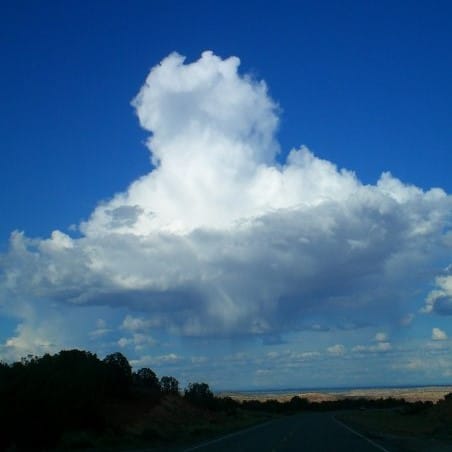
Do you remember lying on your back on the grass and looking at the clouds – finding the shapes, marveling at all the differences? The types, the colors? Looking through old family slides and photos I discovered my father took a lot of pictures of clouds – as do I, my brother and my daughter. There is just something endlessly fascinating about them.
Here in the library we have, not surprisingly, a lot of books on the physics and chemistry of clouds (for resources, check the list below). But for this blog, I’m going to draw on the appearance of clouds in arts and culture. Perhaps it is their beauty and majesty that has attracted scientists to the study of clouds, for that has what has drawn poets, painters, songwriters, and photographers throughout the ages. (Interesting fact: The art of seeing shapes in shapeless forms is pareidolia.)
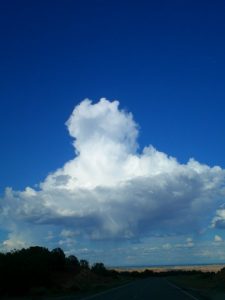
An example of how far back clouds appear in literature, back in the fifth-century, the playwright Aristophanes, “cast a chorus of clouds as the source of ‘airy’ thinking. (pg 7, Clouds). Indeed, there are many sayings about clouds: “head in the clouds,” “nebulous,” “foggy,” and “cloud the issue.” Richard Hamblyn, author of Clouds, wonders if the saying “on cloud nine” might come from a story from the early life of Buddha. The story is that Buddha summoned a small cloud which ferried him over the Ganges, and “the Buddhist cosmology contains a tenfold cloud taxonomy whose stages mirror the tenfold ascent to enlightenment.” The 9th step is “the great bright clouds of refuge,” hence (perhaps) being on cloud nine! There are also frescoes and paintings as clouds from as far back as the 1200s. The fascination with clouds has a long history!
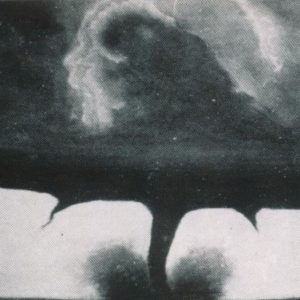
From the early days of photography, photos have been taken of clouds and storms. We may be used to taking cloud photos with our DSLR cameras, or our phones, but the technology in those early days made taking good photos very difficult. It took minutes, not seconds, to take a photo using the photographic plates, and those minutes often made the sky overexposed. One solution, used by many photographers, was to take extra, under-exposed photos and superimpose them over the overexposed plate. Superimposing one photo over another can be used in digital photo editing programs – there has been some controversy concerning the use – and overuse – of digitally edited photos. However, that practice has been going on a long time!
Talking about clouds and photography wouldn’t be complete with touching on clouds and storms in movies and videos. While we are talking tornadoes (see photo at left!), the famous tornado in The Wizard of Oz was constructed from a muslin wind-sock which was suspended from a metal gantry. It is still considered to be one of the most convincing tornadoes in Hollywood history!
And then there’s the music – see the Joni Mitchell quote above. Music and clouds just seem to go together. In 1867 the French astronomer and science writer Camille Flammarion was floating in his hot air balloon. He drifted into a high, thick cloud and could no longer tell in which direction he was traveling. Suddenly he heard instrumental music “which seem[ed] to come from the cloud itself and from a distance of a few yards only from us.” There was high humidity in the cloud and this helped funnel a band concert which was playing in a town square far below. Recently artists have begun to explore the acoustic resonance of the upper atmosphere. In 2004 Usman Haque launched Sky Ear – a cloud of 1,000 helium balloons with a payload of mobile phones, sensor circuits, and flashing LEDs. The phones picked up the whistles and hums that fill the sky – the phones were set to automatically answer therefore letting observers call the phones and listen to the “music of the spheres.”
Musicians and songwriters have long gotten their inspiration from clouds. Here’s a (very) short list (in no particular order)!
- Get Off My Cloud; The Rolling Stones
- Both Sides Now; Joni Mitchell
- Cloud 9; George Harrison
- Kickin’ the Clouds Away; George Gershwin
- Small Dark Cloud; Kenny Rogers
- Three Piano Pieces, EG 100: Storm Clouds
- Floating Clouds; Rick Wakeman
- Heavy Cloud No Rain; Sting
And the list goes on and on!!
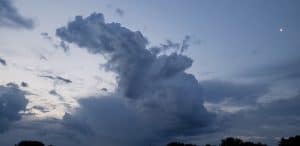
If you are someone who goes around with your “head in the clouds” most of the time there is The Cloud Appreciation Society. Really! It now has over 40,00 members from nearly 120 countries! The society has recently teamed with NASA and have a Cloudspotter app. The information gathered submitted by the app users (from around the globe) will be used by NASA to help calibrate their CERES cloud-observing satellite instruments! You can continue to look up to the skies and help NASA at the same time!
If signing up with the Cloudspotter app isn’t your thing, but you still want to know which clouds are which and what differentiates one cloud from another, The Cloud Book : How to Understand the Skies, has a wealth of information about clouds accompanied by stunning, full-color photographs of each type of cloud.
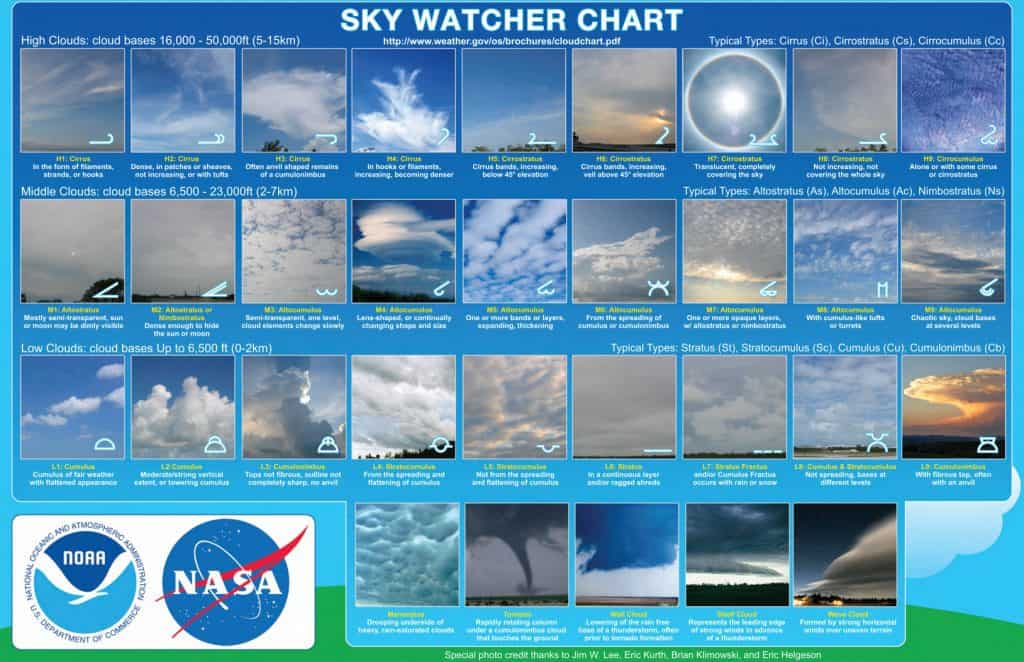
Here’s a Sky Watcher Chart. Go out – look up! How many different types of clouds can you see?
Resources:
Hambly, Richard. 2017. Clouds. London, UK : Reaktion Books, Ltd. Engineering Library QC921 .H35 2017
Lohmann, Ulrike. 2016. Introduction to Clouds, Aerosols and Precipitation. Cambridge University Press. Engineering Library QC921 .L74 2016
CloudSpotter : Your virtual guide to the wonders of the sky. The Cloud Appreciation Society. Date accessed: June 14, 2018.
Hamblyn, Richard. 2008. The cloud book : how to understand the skies. Cincinnati, Ohio : D&C David & Charles : In association with the Met Office. Engineering Library QC921 .H348 2008.
Qiu, Meikang; Keke Gai. 2017. Mobile cloud computing : models, implementation, and security. Boca Raton : CRC Press, Taylor & Francis. Engineering Library QA76.585 .Q58 2017
More Resources:
Randall, David A. 2012. Atmosphere, Clouds, and Climate. Princeton : Princeton University Press. Engineering Library QC981 .R36 2012
Lohmann, Ulrike. 2016. Introduction to Clouds, Aerosols and Precipitation. Cambridge University Press. Engineering Library QC921 .L74 2016
Baianov, I. M. 2011. Cloud Formation. New York : Nova Science Publishers. Engineering Library QC921.6 D95 B35 2011
I am, obviously, not talking about the vast field of cloud computing – that is beyond the scope of this blog. However, if you’d like more information about cloud computing, check the resources below!
Ruparelia, Nayan. 2016. Cloud Computing. Cambridge, Massachusetts : The MIT Press. Engineering Library QA76.585 .R87 2016
Foster, Ian. Dennis B. Gannon. 2017. Cloud Computing for Science and Engineering. Cambridge, Massachesetts : The MIT Press. Engineering Library QA76.585 .F67 2017
